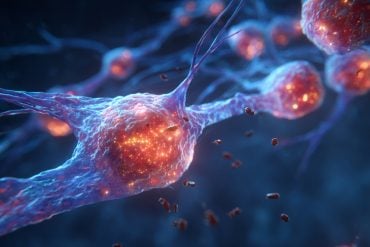Summary: Researchers used ultrasound to penetrate the blood-brain barrier, delivering a chemotherapy and immunotherapy drug combo to treat glioblastoma. This innovative approach boosted the immune system’s recognition of cancer cells, showing promise for a new treatment method.
Key Facts:
- Ultrasound device enables drug delivery through the blood-brain barrier.
- Combined chemo and immunotherapy enhances immune system attack on cancer.
- A clinical trial will test this method’s safety and effectiveness in prolonging survival.
Source: Northwestern University
In a major advance for the treatment of the deadly brain cancer glioblastoma, Northwestern Medicine scientists used ultrasound technology to penetrate the blood-brain barrier and provide a small dose of a chemotherapy and immunotherapy drug cocktail.
The study found that this treatment boosted the immune system’s recognition of the cancer cells and could lead to a new treatment approach.

The scientists made several breakthroughs reported in a new study to be published in Nature Communications this Thursday, June 6.
Scientists showed for the first time that a skull-implantable ultrasound device can enhance the penetration of the chemotherapy drug doxorubicin and immune checkpoint blockade antibodies — a novel immunotherapy treatment combination — into the human brain.
The device produces microbubbles that temporarily open the blood-brain barrier, allowing the immunotherapy to enter the brain.
The scientists also showed for the first time that a small dose of doxorubicin (smaller than the dose used for traditional chemotherapy regimens) delivered with the immune checkpoint antibodies can boost the recognition of malignant glioblastoma cells by the immune system and reinvigorate the lymphocytes (immune cells) that are in charge of attacking the cancer cells.
An immune checkpoint blockade antibody blocks the deactivation of the immune system by the cancer cells. The immune system has built-in brakes — called immune checkpoints — so it doesn’t overdo it and injure the body when attacking cancer and infections. Glioblastoma evolves to activate the brakes, and therefore, the immune system (i.e., lymphocytes) won’t attack it.
In addition to the tumor cells, glioblastoma contains other cell populations called macrophages and microglia. These are the most abundant components of the tumor microenvironment and the cells that glioblastoma modulates to inhibit lymphocytes.
The study showed that the chemo and antibody cocktail altered these cells, enabling the lymphocytes to recognize and kill the cancer cells.
“This is the first report in humans where an ultrasound device has been used to deliver drugs and antibodies to glioblastoma to change the immune system, so it can recognize and attack the brain cancer,” said co-corresponding author Dr. Adam Sonabend, associate professor of neurological surgery at Northwestern University Feinberg School of Medicine and a Northwestern Medicine neurosurgeon.
“This could be a major advance for the treatment of glioblastoma, which has been a frustratingly difficult cancer to treat, in part due to poor penetration of circulating drugs and antibodies into the brain.”
The study was conducted in four patients who had advanced progression of their tumors. They had already been treated with conventional chemotherapy for their tumors as well as an experimental treatment in a clinical trial, but both times, the tumors returned.
“This is a great example of translational bench-to-bedside-back-to-bench research, which sets an exceptional scenario to learn about the ability of the immune system to kill brain tumors in real-time upon treatment,” said co-corresponding author Catalina Lee-Chang, assistant professor of neurological surgery at Northwestern University Feinberg School of Medicine.
“Given the lack of effective immune response against these deadly tumors, these findings encourage us to envision a potential new treatment approach.”
Clinical trial launched with new treatment
These new findings are the basis for a novel clinical trial that was just launched at Northwestern using the ultrasound to deliver the immunotherapy for glioblastoma. The trial will initially enroll 10 participants to determine the safety of the treatment, followed by 15 additional to measure whether the treatment can prolong survival.
Previous large clinical trials have failed to show that this type of immunotherapy can prolong survival in glioblastoma patients. Sonabend, however, believes that by enhancing the delivery of these antibodies and drugs into the brain and relying on biomarkers that indicate which tumors are most susceptible to immunotherapy, this treatment might be shown to be effective for some glioblastoma patients.
“Here we show in a small cohort of patients that when you use this technology, you can enhance the delivery of the chemotherapy and the antibodies, and change the tumor’s microenvironment, so the immune system can recognize the tumor,” Sonabend said.
Sonabend and Lee-Chang are members of the Robert H. Lurie Comprehensive Cancer Center of Northwestern University and the Malnati Brain Tumor Institute. Sonaband also is director of translational neuro-oncology at Feinberg.
The title of the article is “Ultrasound-mediated delivery of doxorubicin to the brain results in immune modulation and improved responses to PD-1 blockade in gliomas.”
Other Northwestern authors include first author Víctor A. Arrieta, Andrew Gould, Kwang-Soo Kim, Karl J. Habashy, Crismita Dmello, Gustavo I. Vázquez-Cervantes, Irina Palacín-Aliana, Graysen McManus, Christina Amidei, Cristal G. Gomez, Silpol Dhiantravan, Li Chen, Daniel Y. Zhang, Ruth Saganty, Meghan E. Cholak, Surya Pandey, Matthew McCord, Kathleen McCortney, Brandyn Castro, Rachel Ward, Bin Zhang, Jason M. Miska, Maciej S. Lesniak, Craig M. Horbinski, Rimas V. Lukas and Roger Stupp.
Funding: The research was supported in part by the National Cancer Institute grants 1R01NS110703-01A1, 1U19CA264338-01 and 1R01CA245969-01A1 of the National Institutes of Health, grant P50CA221747 SPORE for Translational Approaches to Brain Cancer and the Moceri Family Foundation and the Panattoni family.
A.M. Sonabend and R. Stupp have received funding support for research from Agenus, BMS, and Carthera. Sonabend, Arrieta, Kim, Amidei, and Stupp are co-authors of an IP filed by Northwestern University related to the content of this manuscript. (PCT/US2023/034299). Sonabend has served as a consultant for Carthera and EnClear Therapies.
Stupp has acted or is acting as a scientific advisor or has served on advisory boards for the following companies: Alpheus Medical, AstraZeneca, Boston Scientific, Carthera, Celularity, GT Medical, Insightec, Lockwood (BlackDiamond), Northwest Biotherapeutics, Novocure, Inc., Syneos Health (Boston Biomedical), TriAct Therapeutics, Varian Medical Systems. C. Desseaux, G. Bouchoux, and M. Canney are employees and hold an ownership interest in Carthera. M. Canney, G. Bouchoux, and A. Carpentier have patents related to the ultrasound technology described herein.
R. Stupp is an advisory member and consultant for Carthera. A. Carpentier is a consultant for Carthera. C. Lee-Chang is a co-founder and consultant for Sera BioPharma
About this brain cancer research news
Author: Marla Paul
Source: Northwestern University
Contact: Marla Paul – Northwestern University
Image: The image is credited to Neuroscience News
Original Research: Open access.
“Ultrasound-mediated delivery of doxorubicin to the brain results in immune modulation and improved responses to PD-1 blockade in gliomas” by Adam Sonabend et al. Nature Communications
Abstract
Ultrasound-mediated delivery of doxorubicin to the brain results in immune modulation and improved responses to PD-1 blockade in gliomas
Given the marginal penetration of most drugs across the blood-brain barrier, the efficacy of various agents remains limited for glioblastoma (GBM).
Here we employ low-intensity pulsed ultrasound (LIPU) and intravenously administered microbubbles (MB) to open the blood-brain barrier and increase the concentration of liposomal doxorubicin and PD-1 blocking antibodies (aPD-1).
We report results on a cohort of 4 GBM patients and preclinical models treated with this approach. LIPU/MB increases the concentration of doxorubicin by 2-fold and 3.9-fold in the human and murine brains two days after sonication, respectively.
Similarly, LIPU/MB-mediated blood-brain barrier disruption leads to a 6-fold and a 2-fold increase in aPD-1 concentrations in murine brains and peritumoral brain regions from GBM patients treated with pembrolizumab, respectively.
Doxorubicin and aPD-1 delivered with LIPU/MB upregulate major histocompatibility complex (MHC) class I and II in tumor cells. Increased brain concentrations of doxorubicin achieved by LIPU/MB elicit IFN-γ and MHC class I expression in microglia and macrophages.
Doxorubicin and aPD-1 delivered with LIPU/MB results in the long-term survival of most glioma-bearing mice, which rely on myeloid cells and lymphocytes for their efficacy.
Overall, this translational study supports the utility of LIPU/MB to potentiate the antitumoral activities of doxorubicin and aPD-1 for GBM.






